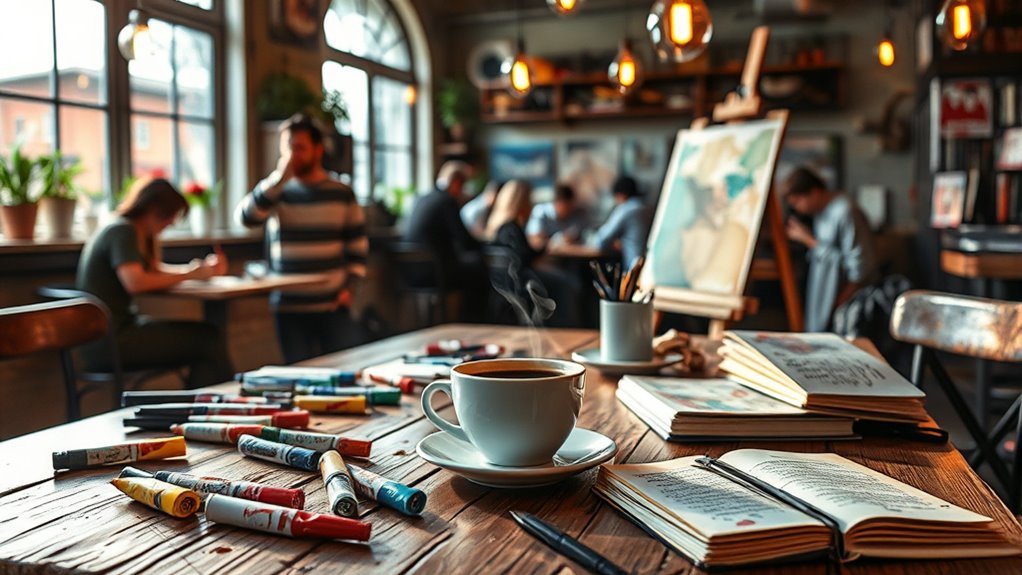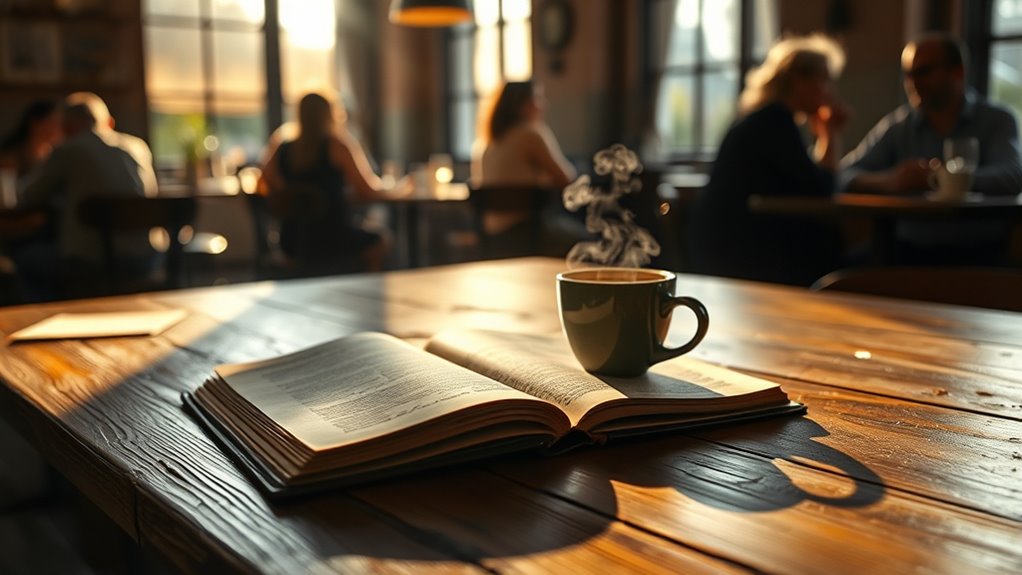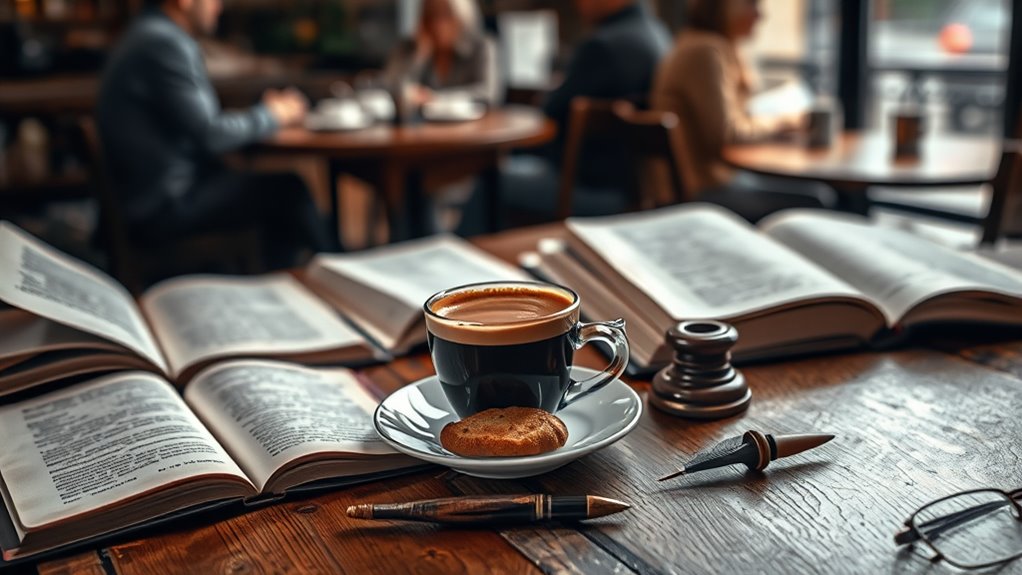Coffee profoundly influences art and literature, sparking creativity among renowned writers and artists. It acts as a muse, inspiring iconic works crafted in bustling coffee shops that serve as collaborative spaces. The ambient noise and social atmosphere fuel brainstorming and idea exchange. Many literary giants, like J.K. Rowling and F. Scott Fitzgerald, found inspiration in these lively environments. If you’re curious about how coffee shapes artistic expression further, you might discover more intriguing connections.
Key Takeaways
- Coffee shops historically serve as creative hubs, inspiring renowned authors like J.K. Rowling and F. Scott Fitzgerald to produce iconic literary works.
- The ambient noise in coffee shops enhances creativity, promoting abstract thinking and problem-solving for artists and writers.
- Coffee symbolizes connection and warmth in literature, facilitating profound discussions and relationships among characters, as seen in works by Dostoevsky and Zadie Smith.
- Coffee houses of the past played a crucial role in intellectual exchange, shaping cultural and political thought during the Enlightenment period.
- Modern coffee culture continues to inspire artistic expression, with events and collaborative projects enhancing community and creativity among artists.
The Cultural Significance of Coffee in Artistic Expression

While you might sip your morning coffee without a second thought, the beverage has long played a pivotal role in shaping artistic expression.
Coffee shops in New York, for instance, have become melting pots of creativity, facilitating intellectual exchange among artists and writers.
Think of Henri Matisse, whose coffee-themed art captures the joy of those slow moments.
Henri Matisse beautifully illustrates the joy of life’s simple pleasures through his enchanting coffee-themed art.
In literature, coffee symbolizes connection, as seen in Zora Neale Hurston’s “Their Eyes Were Watching God.”
Renowned authors like J.K. Rowling and F. Scott Fitzgerald crafted significant works in these vibrant spaces, using coffee as a backdrop for inspiration.
The presence of coffee in narratives like Haruki Murakami’s “Kafka on the Shore” showcases its role in character development, underscoring its cultural significance.
Coffee Shops as Creative Hubs for Writers and Artists

As you step into a coffee shop, you enter a world where creativity thrives and ideas flow freely.
These spaces have historically been gathering spots for influential writers and artists, fueling their imaginative processes. The combination of social interaction and individual work fosters intellectual stimulation, making coffee shops essential creative hubs.
Here’s what makes them special:
- Networking Opportunities: Collaborate with fellow creators.
- Cultural Exchange: Share diverse ideas and perspectives.
- Historical Significance: Iconic works were born here.
- Inspiring Atmosphere: The buzz of conversation sparks creativity.
- Unique Dynamic: Balance between focus and social engagement.
In this vibrant environment, inspiration is everywhere, encouraging you to release your creativity and develop your own masterpieces.
The Role of Ambient Noise in Fostering Creativity

How does the ambient noise of a coffee shop influence your creative process? That gentle hum of conversation and the clinking of cups can actually boost your creativity. Research shows that a moderate level of background noise—around 70 decibels—enhances idea generation and problem-solving. This stimulating environment encourages you to explore thoughts freely, alleviating the pressure of silence.
| Ambient Noise | Creativity Boost | Ideal Level |
|---|---|---|
| Gentle hum | Abstract thinking | 70 decibels |
| Clinking cups | Enhanced output | Moderate |
| Relaxed focus | Flow state | Best |
Historical Perspectives: Coffee Houses and Intellectual Exchange

You might find it fascinating how coffee houses transformed into essential hubs for cultural and intellectual exchange in the 17th and 18th centuries.
These spaces not only fostered discussions among writers and thinkers but also became informal libraries that enriched literary output.
As you explore this topic, consider how these gatherings shaped the landscape of ideas and collaboration during that era.
Coffee Houses’ Cultural Impact
While the rise of coffee houses in 17th and 18th century England may seem like a simple trend, these establishments were instrumental in shaping the cultural and intellectual landscape of the time.
You’d find that coffee houses:
- Became informal libraries, allowing the sharing of pamphlets and books.
- Fostered vibrant discussions among writers and intellectuals, enriching literary works.
- Contributed to the spread of Enlightenment ideas, promoting knowledge exchange.
- Served as meeting places for influential figures, shaping political thought.
- Played a significant role in the development of financial journalism.
Ultimately, coffee houses weren’t just about coffee; they were essential to the growth of ideas and creativity, making them fundamental in the evolution of England’s literary and intellectual scenes.
Intellectual Circles and Collaboration
As coffee houses flourished in 17th century England, they became vibrant hubs where diverse groups of thinkers converged, sparking intellectual collaboration like never before.
You’d find merchants, politicians, artists, and writers sharing ideas, leading to rich social interaction that fueled creativity. The first coffee house in Oxford opened in 1650, followed by London’s in 1652, rapidly spreading across major cities.
These venues acted as informal libraries, allowing patrons to read and exchange pamphlets and newspapers, greatly impacting literary output. Notable spots like Wills and Buttons Coffee House attracted literary giants such as John Dryden and Joseph Addison, fostering collaboration and networking.
However, by the late 18th century, the rise of exclusive clubs began to shift the landscape of intellectual exchange.
Notable Literary Figures and Their Coffee Connections

Coffee has long served as a muse for many literary giants, fueling creativity and sparking inspiration in bustling cafes and quiet corners alike.
You’ll find that some of the most renowned authors drew their ideas from the aroma of freshly brewed coffee around them.
- J.K. Rowling crafted early drafts of Harry Potter in Edinburgh’s coffee shops.
- J.D. Salinger scribbled thoughts in New York coffee spots.
- Gertrude Stein thrived in Parisian cafes, fostering artistic collaboration.
- F. Scott Fitzgerald and Ernest Hemingway found camaraderie in Parisian coffee houses.
- Honoré de Balzac consumed countless cups, enhancing his focus while writing.
These connections highlight how drinking coffee played a pivotal role in shaping their literary legacies.
Coffee as a Symbol of Connection in Literature

In literature, the act of sharing coffee often goes beyond mere consumption; it symbolizes the warmth of companionship and the forging of deep connections. The aroma of freshly brewed coffee fills the air, creating an inviting atmosphere that fosters intimacy.
In Zora Neale Hurston’s “Their Eyes Were Watching God,” coffee represents the bond between characters, while Dostoevsky’s coffeehouse scenes in “Crime and Punishment” illustrate its role as a facilitator of connection.
Mahmoud Darwish uses coffee to evoke shared cultural experiences, linking individuals through history. Similarly, Haruki Murakami’s “Kafka on the Shore” showcases coffee as a catalyst, bridging emotional distances and fostering personal revelations. The brewing methods explored in literature often reflect the characters’ emotional states and relationships.
In these narratives, coffee becomes a powerful symbol of connection, enriching relationships through shared moments.
The Impact of Coffee on Visual Arts and Artistic Practices

While sipping a cup of coffee, many artists find themselves immersed in inspiration, leading to a rich exploration of the beverage’s role in visual arts. Coffee became a muse, evident in how artists depict moments of relaxation and connection.
- Artists like Henri Matisse showcase coffee’s presence in daily life.
- Coffee shops serve as vibrant creative spaces, fostering artistic collaboration.
- Works often illustrate social interactions formed over coffee.
- The beverage emphasizes community and cultural significance in visual narratives.
- Artists evoke deeper themes of contemplation, making coffee a catalyst for creativity.
Through these expressions, coffee’s impact on visual arts highlights its role in fostering connections and enhancing artistic practices.
Coffee’s Influence on Romantic Narratives in Literature

As characters navigate the complexities of love, coffee often acts as a silent witness to their intimate moments.
In literature, coffee is everywhere, serving as a backdrop for romantic encounters that symbolize warmth and connection. In Dostoevsky’s “Crime and Punishment,” the protagonist’s meeting with Sonya in a coffeehouse highlights their shared bond.
Similarly, Zadie Smith’s “On Beauty” uses a cup of coffee to enhance emotional depth between characters. The act of sharing coffee signifies companionship, as seen in Haruki Murakami’s works, where it facilitates profound discussions.
Yet, coffee can also reflect emotional distance, like in Raduan Nassar’s “A Cup of Rage,” where a cold cup of coffee symbolizes fading passion.
Consequently, coffee profoundly influences romantic narratives.
Contemporary Coffee Culture and Its Artistic Implications

In today’s world, coffee shops have become vibrant creative spaces where you can connect with fellow artists and share ideas. These bustling hubs not only serve as networking spots but also inspire modern rituals surrounding coffee that fuel your creativity. As you sip your favorite brew, you might just find the spark you need for your next masterpiece. Additionally, global coffee culture plays a significant role in shaping diverse artistic expressions and collaborative projects within these spaces.
Creative Spaces for Artists
Coffee shops have become essential hubs for creativity, offering artists, writers, and intellectuals a unique atmosphere that sparks inspiration.
While sipping coffee, you’ll find the perfect blend of ambiance and stimulation that fuels your creativity. Research shows that the ambient noise enhances abstract thinking, making these spaces ideal for idea generation.
- Fresh brewed coffee complements pastries, providing the perfect fuel.
- Many creators, like J.K. Rowling, find motivation in this setting.
- Coffee shops are often depicted in visual arts and literature.
- They foster collaboration and cultural exchange, much like historical coffeehouses.
- The social environment encourages connection and exploration of new ideas.
Coffee Shops as Networking Hubs
While you sip your favorite brew, you might notice that contemporary coffee shops have transformed into vibrant networking hubs for artists and creatives. The aroma of coffee mingles with the buzz of conversation, creating an environment that sparks collaboration.
Just like J.K. Rowling and J.D. Salinger found inspiration in similar spaces, you can harness the lively atmosphere to brainstorm and exchange ideas. Research shows that the ambient noise in coffee shops enhances creative thinking, making it an ideal backdrop for your next project.
Plus, many coffee shops host events like open mic nights and art showcases, allowing you to connect with local talent and gain exposure. Embracing this blend of social interaction and individual work fosters a thriving artistic community.
Modern Rituals and Inspiration
As you step into a modern coffee shop, the atmosphere invites creativity, offering a unique blend of inspiration and ritual that fuels artistic expression. You can feel the energy as artists and writers alike gather, fueled by freshly brewed coffee.
This contemporary culture transforms coffee shops into vibrant hubs where collaboration thrives.
- Ambient noise enhances abstract thinking.
- Coffee as a vital part of creative rituals.
- Events like poetry readings and art exhibitions.
- Specialty coffee emphasizes craftsmanship.
- Coffee culture intertwines with the arts scene, often leading to enhanced cognitive function that boosts creativity and problem-solving. Awareness of these pitfalls can also help artists manage distractions and maintain focus on their craft.
In this space, you’re not just here to drink coffee; you’re participating in a shared experience that sparks ideas and fosters creativity, proving that coffee is more than just a drink—it’s a catalyst for inspiration. Additionally, many local roasters support small-scale farmers, contributing to the ethical dimensions of this creative environment.
Frequently Asked Questions
How Does Coffee Affect Mood and Creativity?
Coffee can greatly boost your mood and creativity. When you sip that warm cup, the caffeine stimulates your brain, enhancing focus and alertness.
It releases dopamine, which can lift your spirits, making you feel more inspired. You might notice an increase in your ability to think outside the box and generate new ideas.
What Are Popular Coffee Types Preferred by Artists?
When you think about popular coffee types preferred by artists, espresso often tops the list for its bold flavor and quick caffeine boost.
Many also enjoy lattes for their creamy texture and versatility.
Cold brew’s smoothness appeals to those who want a revitalizing drink without bitterness.
You might find artists sipping on cappuccinos for that perfect frothy finish or experimenting with unique blends, seeking inspiration in every cup they create.
Are There Specific Coffee Rituals Among Writers?
You’d think writers just scribble away anytime, but they often have coffee rituals that’d make a barista proud.
You might find them brewing a fresh pot, savoring each sip as if it’s a rare vintage. Some swear by their morning espresso, claiming it’s the secret to inspiration.
Others prefer a quiet corner in a café, where the hustle fuels their creativity.
How Has Coffee Influenced Modern Social Media Art?
Coffee’s become a staple in modern social media art, fueling creativity and connection.
You’ll often see vibrant coffee-inspired visuals, from latte art to coffee-themed graphics, sparking engagement across platforms. Influencers and artists share their morning brews, turning simple cups into aesthetic statements that resonate with followers.
This blend of caffeine culture and digital expression creates a community where coffee lovers and creators unite, making coffee a universal muse in today’s artistic landscape.
What Role Does Coffee Play in Cross-Cultural Artistic Collaborations?
Coffee’s like a universal passport, granting you access to diverse cultures and perspectives.
In cross-cultural artistic collaborations, it acts as the catalyst that sparks creativity and conversation. When you share a cup, barriers fade, and ideas flow freely.
Artists from different backgrounds come together, blending their styles and influences, creating something truly unique.
Conclusion
To sum up, coffee’s rich tapestry weaves through art and literature, connecting creators across time. Picture a bustling café, where the scent of espresso mingles with the sound of clacking keyboards and whispered conversations. It’s here that ideas brew, just like your morning cup. As you sip your latte, remember how this humble bean has sparked creativity, fueled passions, and fostered connections. So, grab your favorite mug and let the inspiration flow—your next masterpiece awaits!









